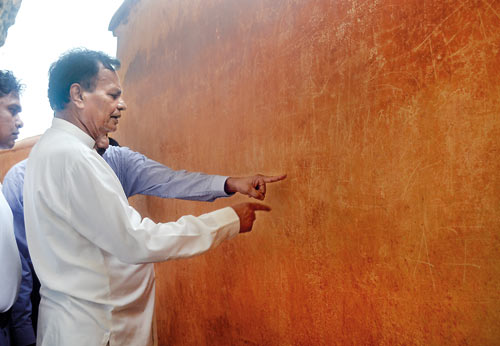News
Glass guard could destroy Sigiriya wall, experts warn
A proposal to have a glass cover as protection for the famed Mirror Wall in the Sigiriya rock fortress has sparked debate, with some claiming it could destroy the wall.
A string of incidents in recent years has prompted authorities to reconsider the proposal of putting up a glass guard over the wall that carries a treasure-trove of jotted graffiti verse written over eight centuries by visitors to the citadel.

Culture and Arts, Minister Nandimithra Ekanayake, examines the Mirror Wall. Pix by Kanchana Kumara Ariyadasa
In the latest incident a 23-year-old girl from Batticaloa who pleaded guilty to writing her name on the Mirror Wall was sentenced to a two-year jail term on Monday by Dambulla Magistrate Sanjeewa Ramyathura.
The girl, Sinnathambi Udeni from Batticaloa, a factory employee, had been visiting Sigiriya with a group of her fellow workers on February 14 – Valentine’s Day – and written “Thanks-Udayan…” by the time guards detected the offence. They arrested her and handed over to police.
A police report filed in court after consultation with the Department of Archaeology revealed that the damage caused was beyond repair.
Last year, a 17-year-old schoolgirl, also from Batticaloa, was arrested for scraping the Mirror Wall with a safety pin but police released her on bail with a warning. Guards have little time to prevent such attacks, the Director-General of the Archaeology Department, Dr. Senarath Dissanayake, suggested.
“Four officials are appointed to protect the area but most people quickly write on the wall. That’s what happened this time: the girl had written on the wall while officials were running towards her,” he said.
A former commissioner of archeology, Dr Raja De Silva, said four guards had previously been able to guard the full length of the Mirror Wall while thousands of people visited the area.
“There was a strong manila rope drawn parallel to the Mirror Wall so that people could not reach it,” he said.
“These days, guards are given phones to keep in touch even though they are a few meters apart but yet they are unable to protect the Mirror Wall.”
The Minister of Culture and Arts, Nandimithra Ekanayake said he was determined to stop recurring destructive actions by installing a glass wall to cover the mirror wall (ketapathpawra) and a glassed roof covering to keep off bird droppings.
The minister said the Archeology Department had taken disciplinary action against the guards over their failure to prevent the latest incident.
Mr. Ekayanake said he would be holding discussions with the Archeology Department this week on installing a glass guard over the wall.
“We need good-quality glass and we are even looking at purchasing the glass from a foreign country, with specific qualities that would make it last long as well as cause no harm to the Mirror Wall,” the minister said, adding that he would solicit the views of specialists in the preservation of archeological sites.
If a glass guard is installed the Mirror Wall should receive adequate ventilation to prevent the humidity destroying the plaster, former Archeology Department Director Dr Shiran Deraniyagala warned.
He said a glass wall should not be mounted for this reason and that installing a net guard was the best option.
Dr Deraniyagala said installing a glass wall should only be done after consulting experts’ views including those from UNESCO.
An official of the Archeology Department who requested anonymity also said glass could adversely affect the plaster.
“Sunlight would create a chemical reaction and would support growth of fungi as well as crack the plaster when over-heating,” he said.
He also said mounting a glass guard on the rock wall would seriously damage the wall and pointed out that a glass covering would encroach on the narrow path along the wall and that a glass roof would allow falling rainwater to carve the rock.
He said former administrative officials had left the issue hanging because one small error would make a big impact on the historical value and preservation of the rock.
Dr. Dissanayake said great care should be taken over installing a glass over the full length of the Mirror Wall.
Priority should be placed on keeping the glass wall ventilated by adding holes in it, he said, also emphasising the views of specialists should be thoroughly canvassed. The Mirror Wall must be kept safe without destroying its visual impact, Dr. Dissanayake said.
Those who cause destruction to archaeological valuable sites are liable to imprisonment of two to five years with a fine ranging from Rs, 50 000 to Rs. 1 million.
The Sigiriya Mirror Wall is a parapet wall covered by a sheet of plaster that had been polished to such a high sheen in olden times that it was said it reflected the frescoes on the opposite wall as well as King Kasyapa’s reflection when he passed by.
It is said the plaster was formed of finely crushed lime, eggwhite and honey and polished with beeswax. When it was built, the wall was white but has become rose-coloured over the centuries.

